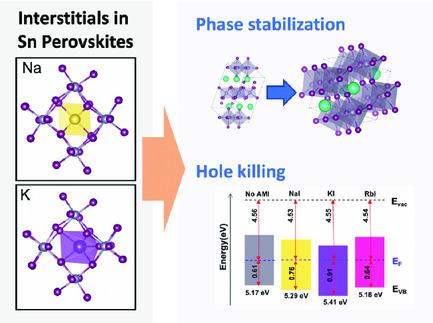Our official English website, www.x-mol.net, welcomes your feedback! (Note: you will need to create a separate account there.)
Interstitial Engineering toward Stable Tin Halide Perovskite Solar Cells
Solar RRL ( IF 7.9 ) Pub Date : 2020-09-23 , DOI: 10.1002/solr.202000513 Jin Hyuck Heo 1 , Jong-Goo Park 2 , Sang Hyuk Im 1 , Ki-Ha Hong 2
Solar RRL ( IF 7.9 ) Pub Date : 2020-09-23 , DOI: 10.1002/solr.202000513 Jin Hyuck Heo 1 , Jong-Goo Park 2 , Sang Hyuk Im 1 , Ki-Ha Hong 2
Affiliation

|
Sn‐based halide perovskites are the most promising alternatives for developing Pb‐free perovskite solar cell materials. However, the stability of Sn halide perovskites is the biggest concern for future developments. The phase stability and the doping‐level control should be resolved for Sn perovskites to compete with Pb‐based analogs. Herein, interstitial engineering is used to enhance the stability of Sn‐based halide perovskites using alkali metals through ab initio calculations and controlled experiments. This study reveals that alkali metal interstitials can promote the performance of Sn perovskites by controlling their phase stability, suppressing free carrier density, and locking lattice vibration. K+ shows the most promising behavior among alkali–metal cations in terms of phase stabilization and defect formation energy.
中文翻译:

稳定的卤化锡钙钛矿太阳能电池的填隙工程
锡基卤化物钙钛矿是开发无铅钙钛矿太阳能电池材料的最有前途的替代品。然而,卤化钙钛矿的稳定性是未来发展的最大关注点。应该解决Sn钙钛矿的相稳定性和掺杂水平控制问题,以使其与基于Pb的类似物竞争。在本文中,通过从头算和受控实验,采用间隙工程技术来使用碱金属增强Sn基卤化物钙钛矿的稳定性。这项研究表明,碱金属间隙物可以通过控制它们的相稳定性,抑制自由载流子密度和锁定晶格振动来提高钙钛矿的性能。K + 在相金属稳定和缺陷形成能方面,它显示了碱金属阳离子中最有前途的行为。
更新日期:2020-09-23
中文翻译:

稳定的卤化锡钙钛矿太阳能电池的填隙工程
锡基卤化物钙钛矿是开发无铅钙钛矿太阳能电池材料的最有前途的替代品。然而,卤化钙钛矿的稳定性是未来发展的最大关注点。应该解决Sn钙钛矿的相稳定性和掺杂水平控制问题,以使其与基于Pb的类似物竞争。在本文中,通过从头算和受控实验,采用间隙工程技术来使用碱金属增强Sn基卤化物钙钛矿的稳定性。这项研究表明,碱金属间隙物可以通过控制它们的相稳定性,抑制自由载流子密度和锁定晶格振动来提高钙钛矿的性能。K + 在相金属稳定和缺陷形成能方面,它显示了碱金属阳离子中最有前途的行为。



























 京公网安备 11010802027423号
京公网安备 11010802027423号